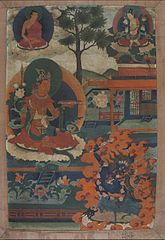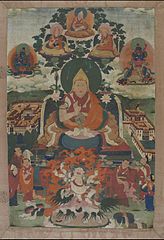The Jebtsundamba Khutuktu or Khalkha Jetsün Dampa Rinpoche is a title given to the spiritual head of the Gelug lineage of Tibetan Buddhism in Mongolia. They also hold the title of Bogd Gegeen, making them the top-ranked lama in Mongolia.
The Drukpa or Drukpa Kagyu lineage, sometimes called Dugpa in older sources, is a branch of the Kagyu school of Tibetan Buddhism. The Kagyu school is one of the Sarma or "New Translation" schools of Tibetan Buddhism. The Drukpa lineage was founded in the Tsang region of Tibet by Tsangpa Gyare (1161–1211), and later became influential in Ladakh and Bhutan. It is one of several lineages known as "Red Hat sects".
Ngawang Lobzang Jampel Tsultrim Gyatso or Tsultrim Gyatso was the 10th Dalai Lama of Tibet, and born in Chamdo. He was fully ordained in the Gelug school of Tibetan Buddhism, studied the sutras and tantras, had several students, and rebuilt the Potala Palace.

Zhabdrung was a title used when referring to or addressing great lamas in Tibet, particularly those who held a hereditary lineage. In Bhutan the title almost always refers to Ngawang Namgyal (1594–1651), the founder of the Bhutanese state, or one of his successive reincarnations.

Sera Monastery is one of the "great three" Gelug university monasteries of Tibet, located 1.25 miles (2.01 km) north of Lhasa and about 5 km (3.1 mi) north of the Jokhang. The other two are Ganden Monastery and Drepung Monastery. The origin of its name is attributed to a fact that during construction, the hill behind the monastery was covered with blooming wild roses.

Drepung Monastery, located at the foot of Mount Gephel, is one of the "great three" Gelug university gompas (monasteries) of Tibet. The other two are Ganden Monastery and Sera Monastery.

Ralung Monastery, located in the Tsang region of western Tibet south of Karo Pass, is the traditional seat of the Drukpa Lineage of Tibetan Buddhism. It was founded in 1180 by Tsangpa Gyare, 1st Gyalwang Drukpa, a disciple of Lingje Répa who founded the Drukpa Lineage.
Ralung is one of the most sacred places in Tibet, for it is here that the great Dugpa school of red-hat monks originated, a school still influential with numerous adherents in Southern, Northern, and Eastern Tibet, and in Bhutan, which latter country is, in fact, called Dugpa owing to the preponderance of this sect. The Ralung-til, the head monastery of the Dugpa, is to the south-east of this village. This monastery owes its name to the fact that it is surrounded by mountains as the heart (mt'il) of a lotus is by the corolla.

Lopön Tenzin Namdak is a Tibetan religious leader and the most senior teacher of Bon, in particular of Dzogchen and the Mother Tantras.

Palyul Monastery, also known as Palyul Namgyal Jangchub Choling Monastery and sometimes romanized as Pelyul Monastery, is one of the "Six Mother Monasteries" of the Nyingma tradition of Tibetan Buddhism. It was founded in 1665 by Rigzin Kunzang Sherab in Pelyul in Baiyü County, Garzê Tibetan Autonomous Prefecture in China's Sichuan province, on the eastern edge of Tibet in Kham. The monastery is the seat of the Nam Chö Terma of Terton Mingyur Dorje. Drubwang Padma Norbu was the 11th throneholder of the Palyul lineage. Upon his mahaparinirvana in March, 2009, Karma Kuchen Rinpoche became the 12th throneholder.

Trülku Drakpa Gyeltsen (1619–1656) was an important Gelugpa lama and a contemporary of the 5th Dalai Lama (1617–1682). His Seat was the upper residence of Drepung Monastery, a famous Gelug gompa located near Lhasa.

The Phagmodrupa dynasty or Pagmodru was a dynastic regime that held sway over Tibet or parts thereof from 1354 to the early 17th century. It was established by Tai Situ Changchub Gyaltsen of the Lang family at the end of the Yuan dynasty. The dynasty had a lasting importance on the history of Tibet; it created an autonomous kingdom after Yuan rule, revitalized the national culture, and brought about a new legislation that survived until the 1950s. Nevertheless, the Phagmodrupa had a turbulent history due to internal family feuding and the strong localism among noble lineages and fiefs. Its power receded after 1435 and was reduced to Ü in the 16th century due to the rise of the ministerial family of the Rinpungpa. It was defeated by the rival Tsangpa dynasty in 1613 and 1620, and was formally superseded by the Ganden Phodrang regime founded by the 5th Dalai Lama in 1642. In that year, Güshi Khan of the Khoshut formally transferred the old possessions of Sakya, Rinpung and Phagmodrupa to the "Great Fifth".

Nangzhik Monastery, formerly known by several other names, is a monastery of the Bon religion in Amdo, modern Ngawa Town, Sichuan, China. It is about a 4 kilometres (2.5 mi) walk up a shortcut to reach the monastery on a hill to the north of the town. On a hill to the east is another Bon monastery named Togden or Topgyel which has a large stupa nearby.
The Changkya Khutukhtu was the title held by the spiritual head of the Gelug lineage of Tibetan Buddhism in Inner Mongolia during the Qing dynasty.
Chökyi Gyeltshen (1402–1473) was a Tibetan spiritual leader. He was the sixth Ganden Tripa of the Gelug school of Tibetan Buddhism from 1463 to 1473. He was also the 1st Tatsak Rinpoche.
Pagsam Wangpo, a key figure in the history of the Drukpa Lineage of Tibetan Buddhism, was born at Chonggye, in the Tsang province of Tibet a natural son of the prince of Chonggye, Ngawang Sonam Dragpa. He was an elder cousin of the 5th Dalai Lama, Ngawang Lobzang Gyatso (1617-1682).
Duldzin Dragpa Gyaltsen (1374-1434), the first Kyorlung Ngari Tulku, was one of the principal disciples of Je Tsongkhapa, the founder of the Gelugpa school of Tibetan Buddhism.

Yeshe Lobsang Tenpai Gonpo was the 8th Tatsag, a Tibetan reincarnation lineage. From 1789 to 1790 and from 1791 until his death in 1810 he was regent of Tibet, appointed by the Qing dynasty of China. He was the first owner of the Kundeling Monastery, founded in 1794 in Lhasa.

The Tatsag or Tatsak lineage is a Tibetan Buddhist reincarnation lineage whose first member was Baso Chokyi Gyaltsen (1402–73). Since 1794 the Tatsag has been the owner of the Kundeling Monastery in Lhasa. There has been some controversy over the representative of the lineage in recent years.
The Noyon Khutagt is a monk of the Nyingma school of Tibetan Buddhism in the Gobi region of Mongolia. The present Noyon Khutagt is believed to be the ninth incarnation of the original Mongolian Noyon Khutagt, who himself was believed to be a reincarnation of a much earlier person in Tibetan Buddhist history.
Norbu, with the later title of Depa and also known as Nangso Norbu, was a Tibetan government official born in the Central Tibetan province of Ü around the end of the 16th century. In 1644 he was appointed Governor of Shigatse, a post he held until 1659 when he succeeded his elder brother, Desi Sonam Rapten as de facto ruler of Tibet on behalf of Lobzang Gyatso, the Fifth Dalai Lama. After a brief reign he rebelled unsuccessfully against the latter and was banished. His last recorded activity was in 1660.



















